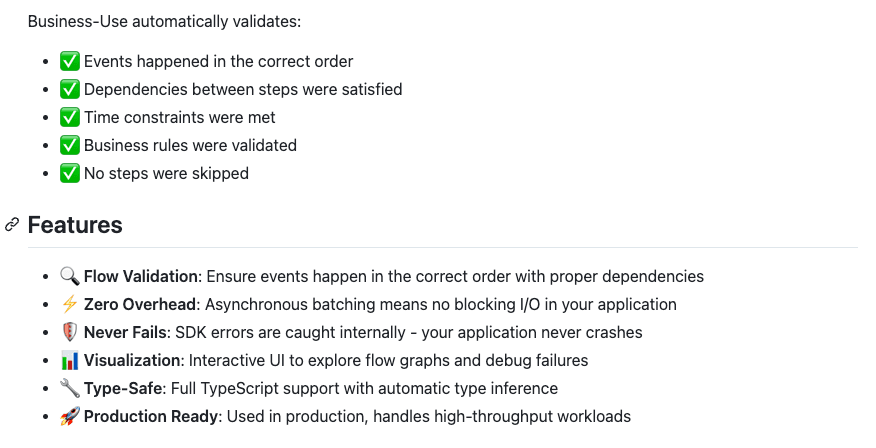Foundation — Book V: The Handoff Zone
Where your business logic goes to die
TL;DR: The handoff zone between backend and frontend is where business logic silently breaks. Traditional monitoring can't track multi-request flows, but Business-Use framework fills this gap by treating the entire flow as a single verifiable unit across service boundaries.

Your payment API returns 200. Your frontend renders the success screen. Two hours later, a customer emails: their card was charged, but they never got their order confirmation.
This failure happened in the gap between backend and frontend, the handoff zone where events cross service boundaries, where your observability goes dark, and where your business logic silently breaks.
The verification blind spot
We've gotten good at testing backends. Unit tests verify business logic. Integration tests check API contracts. Distributed traces show requests flowing through microservices.
We've gotten good at testing frontends. Component tests validate UI behavior. E2E tests click through happy paths. Error boundaries catch React explosions.
But the handoff zone, the place where backend events should trigger frontend updates, where API responses should sync with UI state, where webhooks should propagate to user notifications—remains a verification blind spot.
Traditional monitoring tells you the payment service is up. It tells you the frontend loaded. It cannot tell you if the payment event actually reached the order confirmation system, or if the inventory update triggered the UI refresh, or if the webhook fired but the frontend state never changed.
Why distributed traces aren't enough
OpenTelemetry traces give you visibility into request flows. You can follow a payment through your backend services, see every database query, track every network call. But traces are request-scoped. They show you what happened during a single synchronous operation.
Business flows are multi-request. A customer clicks "checkout." Your backend processes the payment. An async job updates inventory. A webhook notifies the shipping system. The frontend polls for order status. Each step generates its own trace, its own context, its own isolated view of reality.
The trace that shows the payment succeeding is disconnected from the trace that shows inventory updating. Neither trace knows if the other happened. Neither can tell you if the business invariant ("paid orders must decrement inventory") actually held true.
What we're releasing
Business-Use is a lightweight framework for tracking and validating business flows across the backend-frontend boundary.
You instrument your code with expectations about what should happen:
from business_use import ensure
ensure(
id="payment_processed",
flow="checkout",
run_id=order_id,
data={"amount": order_amount, "status": "completed"}
)
ensure(
id="inventory_updated",
flow="checkout",
run_id=order_id,
depends_on="payment_processed",
validator=lambda data, ctx: data["quantity"] < 0,
description="Inventory must decrease after payment"
)Business-Use tracks these events as they fire across your stack—backend services, frontend state changes, webhook handlers—and validates that your business invariants hold. It detects when a payment processes but inventory never updates. It catches when a webhook fires but the UI never reflects the change. It surfaces violations in real time, before customers notice.
The gap in the market
The distributed systems verification landscape offers powerful tools for specific problems. Antithesis finds deep bugs through deterministic simulation. Temporal guarantees workflow durability. Tracetest validates individual traces. But all of these operate on one side of the divide.
Backend verification tools don't see frontend state changes. Frontend monitoring doesn't see backend event streams. The handoff zone—where backend events should propagate to frontend updates—remains unmonitored, untested, and unverified.
Business-Use fills this gap. It treats the entire flow, backend to frontend, as a single verifiable unit. It validates that the business logic you wrote actually executes correctly in production, across service boundaries, across async operations, across the entire stack.
How it works
Business-Use runs a lightweight agent in your backend and frontend. When you call ensure(), the SDK captures the event—along with its data, dependencies, and validation rules—and sends it asynchronously to a central validation service. The service builds a state machine for each business flow, tracking which events have fired and checking if they satisfy the dependencies and validators you defined.
When a violation occurs—a payment without an inventory update, a webhook without a UI change—Business-Use surfaces it immediately. You see which event failed, which dependency was missing, and what data was involved. You can replay the flow, inspect the state transitions, and debug the gap in your business logic.
Zero overhead. Asynchronous batching means no blocking I/O. SDK errors are caught internally—your application never crashes because of instrumentation. The validation happens out-of-band, invisible to your users, surfacing only when your business logic breaks.
The future of business logic verification
The tools for verifying distributed systems are converging. Formal methods are moving from abstract TLA+ models to executable code. Chaos engineering is becoming deterministic. Observability is evolving from metrics and traces to assertions and invariants.
Business-Use extends this convergence across the backend-frontend divide. It takes the runtime verification concepts developed for microservices and applies them to the full stack. It treats a button click and a database write as parts of the same verifiable flow.
Your business logic doesn't stop at the API boundary. Your verification shouldn't either.
Business-Use is open source and available now at github.com/desplega-ai/business-use.
Related Posts
Foundation — Book IV: Cost of Poor Quality
Master the Cost of Poor Quality framework to transform quality from a cost center to a revenue driver.
Test Wars Episode VII: Test Coverage Rebels
Join the rebellion against meaningless test coverage metrics. Learn how to build meaningful test suites.
Foundation — Book III: Fire Your QA Director
When to replace QA leadership vs. fix systemic quality issues. Transform QA from reactive to proactive.